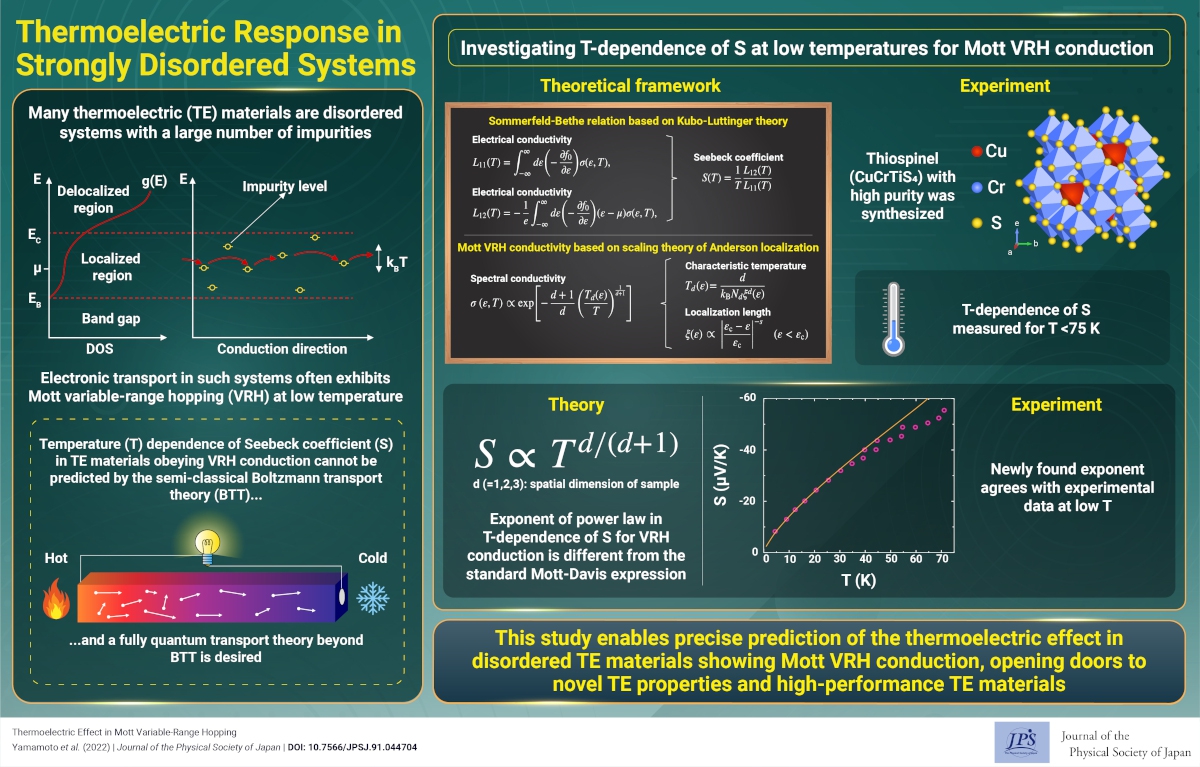Thermoelectric Response in Strongly Disordered Systems
© The Physical Society of Japan
This article is on
Thermoelectric Effect in Mott Variable-Range Hopping
J. Phys. Soc. Jpn. 91, 044704 (2022).
Based on the Kubo–Luttinger linear response theory, we discovered that the low-T Seebeck coefficient for Mott variable-range hopping in a d-dimensional system varies as S ∝ Td/(d+1), which is different from the conventional S ∝ T(d−1)/(d+1). In addition, the experimental data for S of CuCrTiS4 at low T are in excellent agreement with our prediction S ∝ T3/4 (d = 3).

In 1957, Kubo established the linear response theory to kinetic perturbation (e.g., electric or magnetic field). In the following years, based on the combination of the thermal Green's function technique with the Kubo formula, the linear response theory has emerged as a powerful practical tool for analyzing quantum transport and the magnetic response of materials. In contrast, the linear response theory to thermodynamic perturbation (e.g., temperature gradient) was advocated by Luttinger in 1964. Luttinger succeeded in treating the temperature gradient as a kinetic perturbation by introducing a fictitious gravitational field (scalar field). Since 2018, the authors and their co-workers have been developing the Luttinger formula together with the thermal Green's function technique to determine the thermal response (i.e., thermoelectric (TE) effect and thermal transport) of materials from a quantum mechanical perspective. The developed technique has been successfully applied to various materials exhibiting interesting TE effects that cannot be explained in terms of the Boltzmann transport theory (BTT).
In this study, as a typical thermal response beyond the BTT framework, the authors investigated the TE response in Mott variable-range hopping (VRH) using the above-mentioned Kubo–Luttinger (KL) theory together with the thermal Green's function technique. By incorporating the energy dependence of the localization length near the mobility edge based on the scaling theory of Anderson localization, we clarified that the Seebeck coefficient S(T) varies according to S ∝ Td/(d+1) in a d-dimensional system, which is different from the widely used Mott–Davis expression, S ∝ T(d−1)/(d+1), based on the energy-independent localization length. In addition, we demonstrated that the low-T behavior of S(T) for thiospinel CuCrTiS4, which is known as a typical TE material exhibiting Mott VRH at low T, is in complete agreement with our theoretical prediction S ∝ T3/4 (d = 3).
This study enables precise prediction of the performance of disordered TE materials exhibiting Mott VRH. The development of such a complete quantum theory that precisely predicts TE properties will play a role in realizing a sustainable society.
(Written by T. Yamamoto on behalf of all the authors.)
Thermoelectric Effect in Mott Variable-Range Hopping
J. Phys. Soc. Jpn. 91, 044704 (2022).
Share this topic
Fields
Related Articles
-
Exploring Electronic States in BEDT-TTF Organic Superconductors
Superconductivity
Electronic transport in condensed matter
Magnetic properties in condensed matter
2024-4-24
This review, published in the Journal of the Physical Society of Japan, provides a comprehensive summary of the electronic states observed in BEDT-TTF type organic superconductors, including metal-insulator transitions, Mottness transitions, non-Fermi liquids, quantum spin liquids, and Bose-Einstein condensation.
-
Conversion of Chiral Phonons into Magnons in Magnets
Electronic transport in condensed matter
2024-4-1
A new phenomenon involving the conversion of chiral phonons into magnons is theoretically predicted. The effective magnetic field induced by chiral phonons causes a change in the spin magnetization of magnets.
-
Variety of Mechanically Induced Spin Currents in Rashba Systems
Electronic transport in condensed matter
Magnetic properties in condensed matter
Structure and mechanical and thermal properties in condensed matter
2024-3-22
Various types of spin currents, including unconventional types, are generated in Rashba spin-orbit coupled systems by dynamic lattice distortions associated with, for example, surface acoustic waves.
-
What Determines the Sign of Spin Current? ~ Theoretical Study of Spin Seebeck Effect in Antiferromagnetic Insulators
Electronic transport in condensed matter
2024-3-18
We developed a microscopic theory for the spin Seebeck effect in antiferromagnets, that explains the sign reversal of the spin current at the spin-flop transition point and describes the sorts of dominant carriers.
-
Chiral Anomalies in Organic Dirac Semimetals
Electronic transport in condensed matter
2024-2-5
A three-dimensional massless Dirac fermion system exhibiting broken chiral symmetry was successfully realized in organic conductor α-(BEDT-TTF)2I3 under high pressures. Our study detected the chiral anomaly-induced negative magnetoresistance and planar Hall effects and opened new avenues for further advancements in the field.
